This Isn’t a Prototype. It’s a Fully Designed Civic Platform. Ready to Be Built
Fund the infrastructure, not the hype. 200 Brady Street isn’t a startup idea or speculative app. It’s a fully designed, governed, and milestone aligned civic platform for traffic enforcement transparency, built from the ground up to protect contributors, expose enforcement blind spots, and make public records truly public.
The system is designed to roll out in structured layers, from ticket visibility, to FOI transparency, to legal recovery. Milestone 1 brings the first layer to life: real ticket reports, structured public stats, and contributor protection, launching in three cities chosen for origin, scale, and contrast:
- Sudbury Ontario, where the project began and where the system was first needed
- Toronto, Canada’s largest city, where automated enforcement now generates over $70 million annually from red light and speed camera fines, with both programs actively expanding under the city’s Vision Zero plan
- New York City, where automated enforcement issued over 16.1 million violations in fiscal year 2024, totaling approximately $1.09 billion in fines
These cities aren’t random pilots. They’re deliberate entry points into enforcement systems that operate at scale, and where civic visibility is overdue.
What’s needed now isn’t exploration funding.
It’s aligned capital to activate Milestone 1 and begin building what comes next.
Automated enforcement generates an estimated $20B–$50B in fines globally every year. And there’s still no public infrastructure tracking where that money goes. That’s the audit layer 200 Brady Street is building.
View Milestone Overview
Request Briefing / Deck
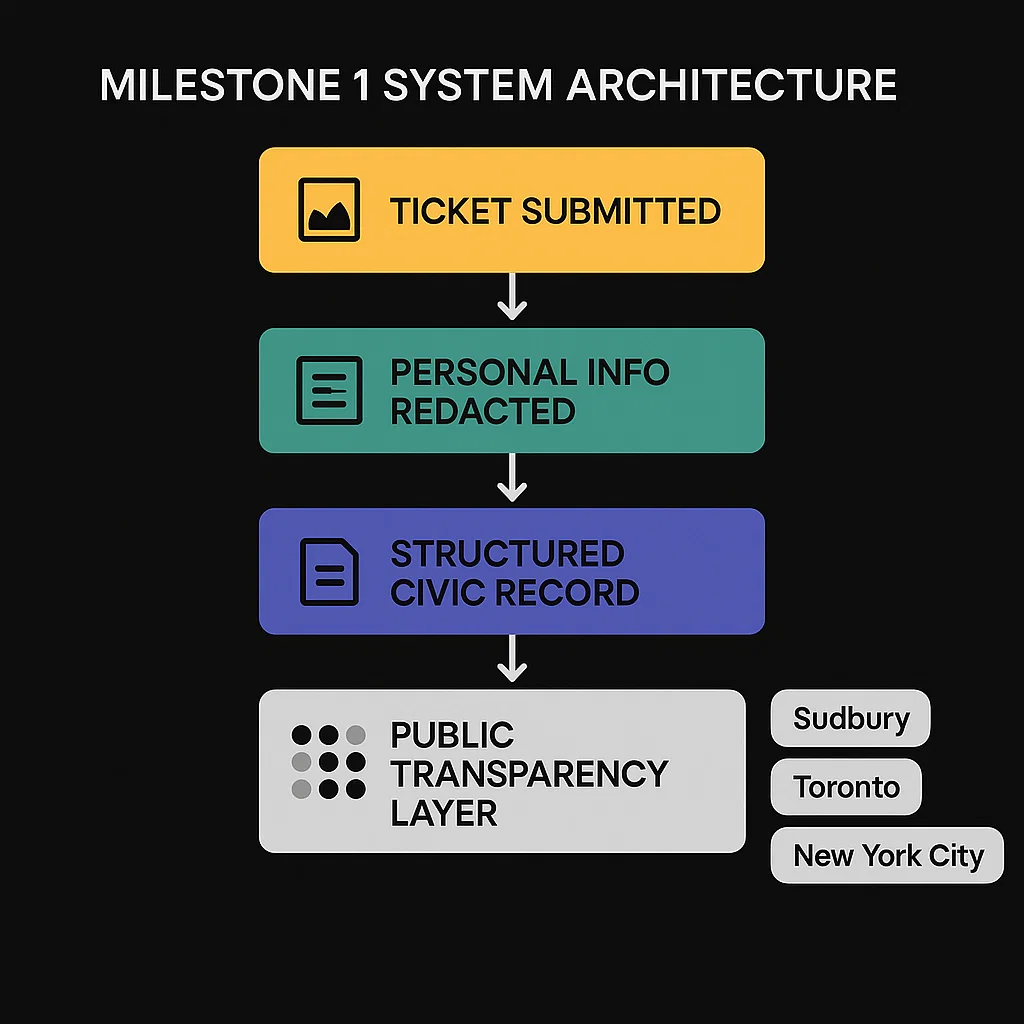
What You're Funding Has Already Been Mapped, Down to the Last Safeguard
This isn’t a feature list or a prototype waiting for discovery. Every flow, from submission to redaction, labeling, public stats, and access logic has already been designed and governed. The sections below walk through what’s ready to launch, what the capital will activate, and why every milestone serves a public first model.
THIS ISN’T AN MVP. IT’S A GOVERNED SYSTEM, READY TO STAND UP
Every Flow Has Already Been Mapped, Reviewed, and Structured for Launch
Nothing on this platform is improvised. The submission flows, redaction logic, data labels, contributor tiers, and public access structures have all been mapped in advance, not backfilled after funding.
The goal was never just to build something that worked. It was to build something that couldn’t quietly drift. That meant defining safeguards before launch, not after.
What’s already designed and ready to be built:
- Ticket uploads via photo or manual entry, Ai assisted, fully redacted
- Labeling logic for Verified and Community ticket reports
- Trust tiers based on transparency, not gamification
- Contributor protection rules, no names, no PII, no surveillance ads
- Public dashboards designed for civic access. with revenue flows that reinforce trust, not exploit it.
- Access tiers built to serve legal clinics, researchers, and transparency orgs
This is what aligned capital activates, not a sprint to MVP, but a system built to serve public oversight on day one.
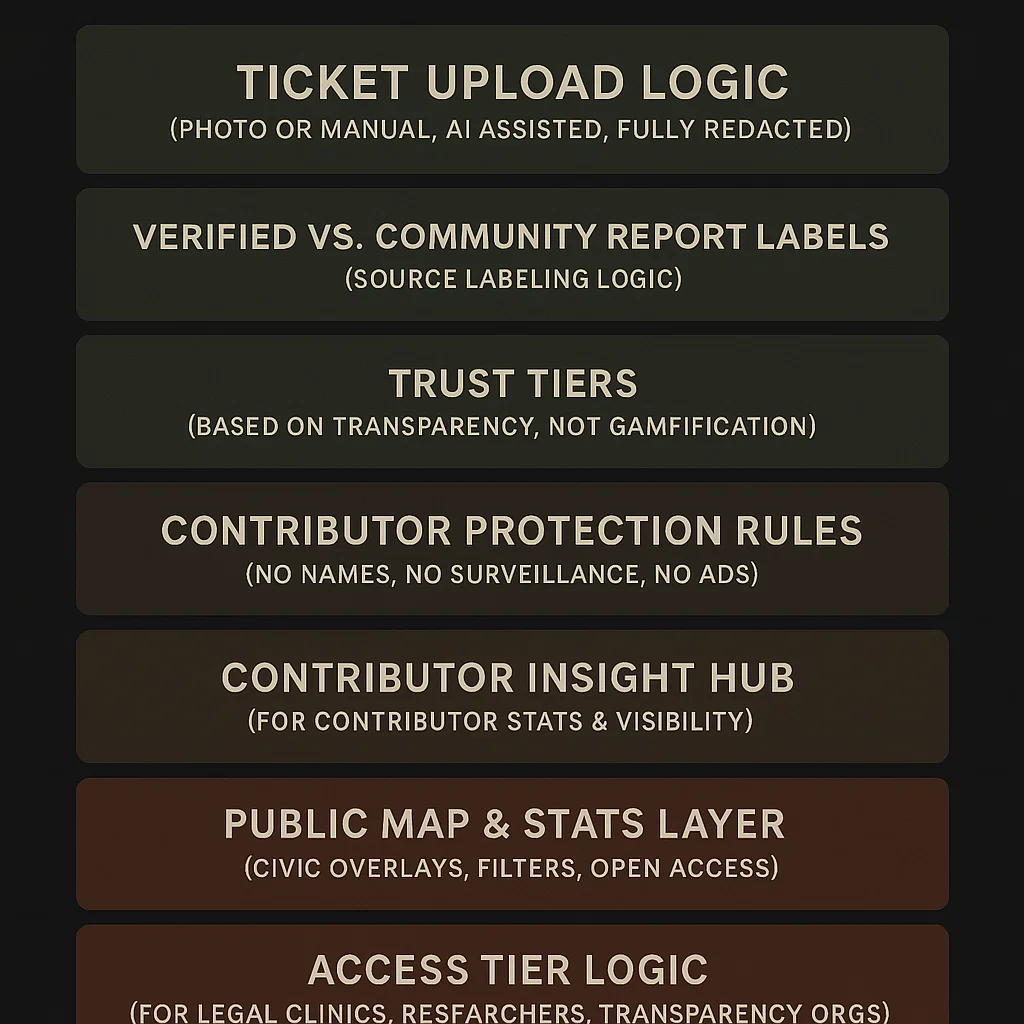
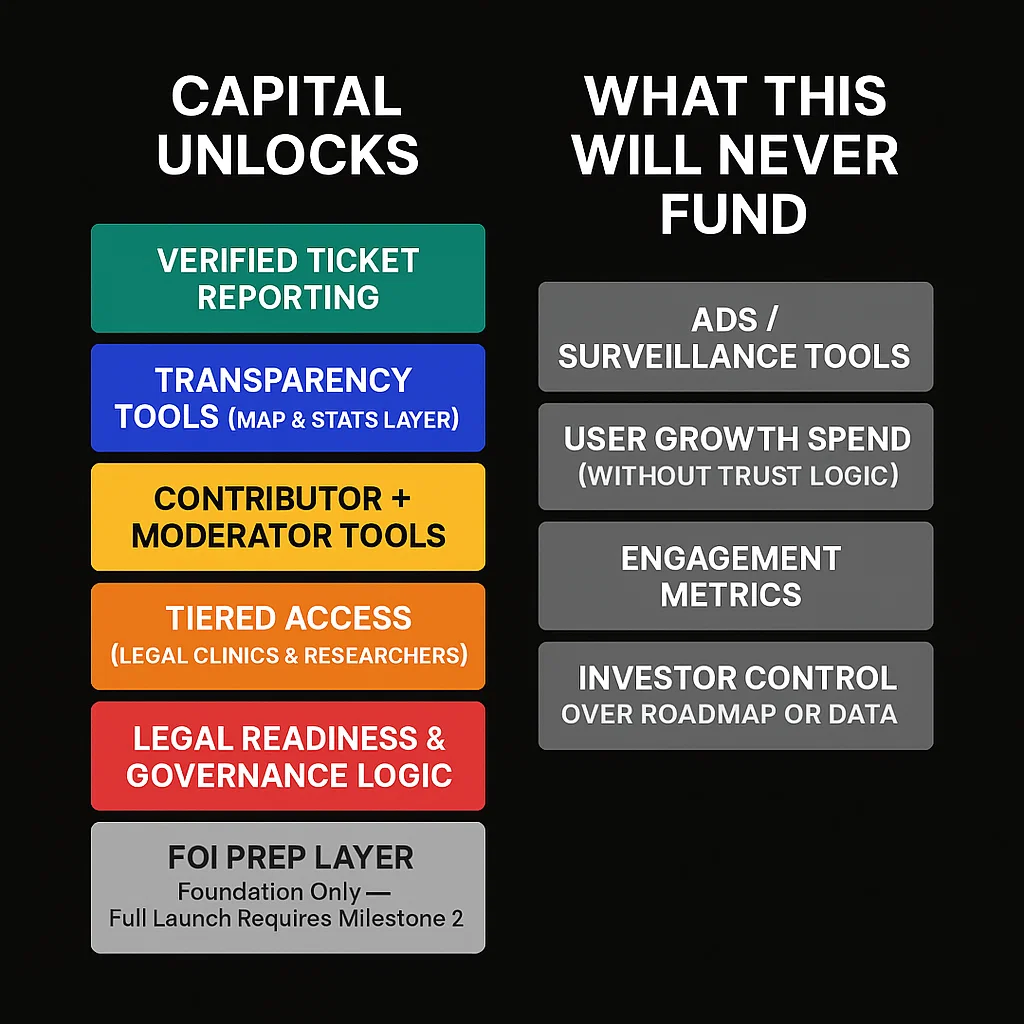
WHAT ALIGNED CAPITAL UNLOCKS AND WHAT IT NEVER WILL
This Raise Activates the Platform’s First Layer. Not a Growth Sprint
This isn’t an open ended build or MVP sprint. It’s a scoped, milestone aligned launch of a public system that’s already mapped technically, legally, and ethically.
Aligned capital activates what’s ready:
- Verified ticket reporting with redaction by default
- City level dashboards and public transparency tools
- Contributor and moderator tools with audit trails
- Tiered access models for legal clinics and researchers
- Legal review and onboarding logic for civic-scale integrity
- FOI readiness layer to support Milestone 2 infrastructure
What this raise does not fund:
- Ads, surveillance tools, or engagement metrics
- “User growth” spend without trust logic
- Investor control over roadmap or data flows
This platform isn’t “early stage.” It’s structured for civic accountability from day one.
CAPITAL THAT FITS THE MISSION AND WON’T COMPROMISE IT
This Platform Isn’t for Everyone. And That’s the Point.
This isn’t a venture backed sprint to scale. It’s a governed platform with irreversible public commitments and the capital it accepts must reflect that.
We welcome:
- Civic minded angel investors
- Legaltech and FOI advocates
- Research aligned impact funds
- Mission first public infrastructure backers
We do not accept:
- Enforcement linked funders
- Insurer or scoring model interests
- Municipal control buyers
- Funds seeking override or product control
There is no backdoor to data, no optional surveillance layer, and no investor override clause. The governance is active, not pending.
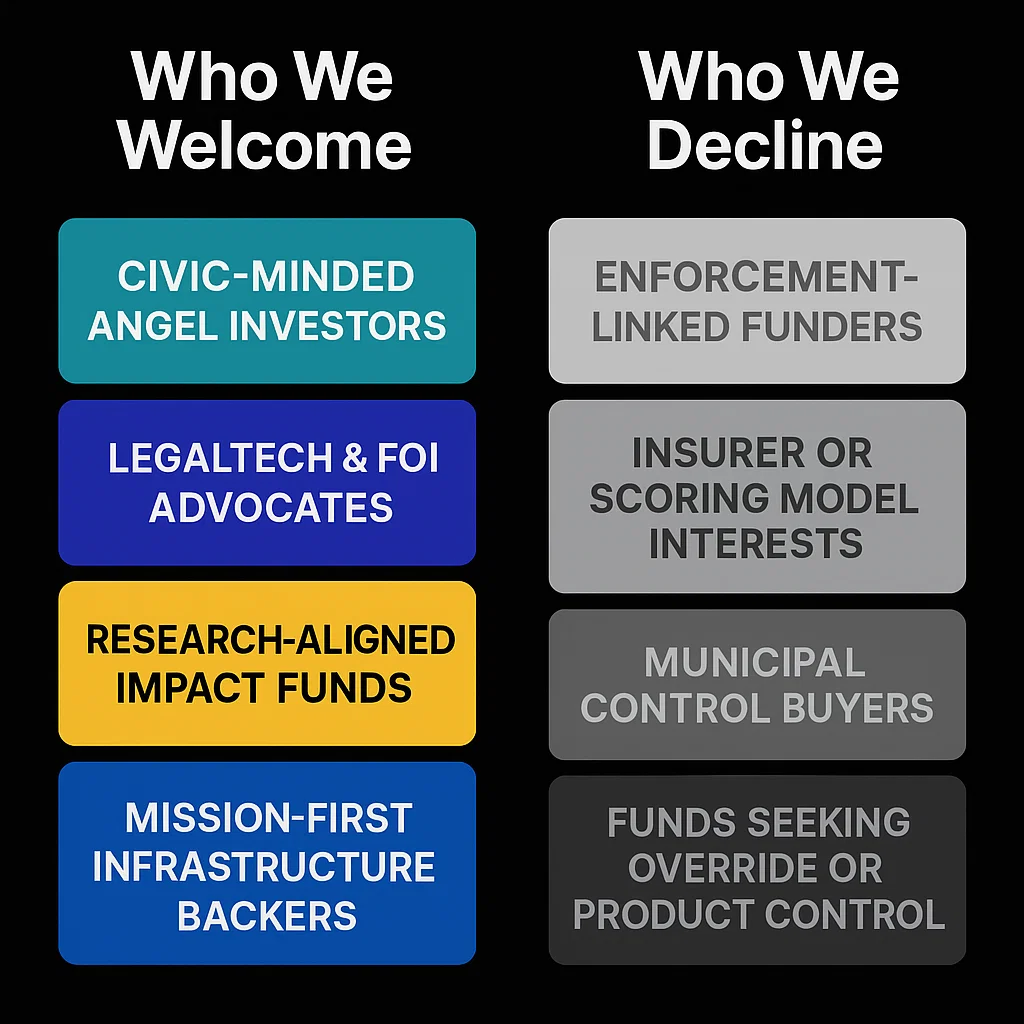
Yes, It Makes Money. Just Not the Usual Way
This system was designed to sustain itself through aligned licensing, not user surveillance. The revenue model is mapped, governed, and fully constrained with public interest value built into every tier
REVENUE IS BUILT IN BUT NEVER AT THE COST OF TRUST
The Model Sustains Itself Without Exploiting Users or Selling Access
This platform is designed to generate civic value and sustain itself without exploitation. Revenue isn’t bolted on. It’s part of the architecture, shaped by contributor protection and aligned access, not ad targeting or data reselling.
The revenue model is already mapped:
- Civic+ subscriptions: for journalists, researchers, and transparency allies who need advanced tools and stats
- Legal recovery tools: optional referrals, class action prep, and dispute bundling features for legal clinics
- Academic and public interest licensing: with reciprocity clauses that prevent data lock up or resale
- FOI and bylaw infrastructure: opt-in services that help civic orgs host and index public records not city dashboards
- Vetted sponsorships only: support from legal aid groups, justice tech, or FOI platforms, never surveillance ads or commercial insurers
There are no user data sales. No enforcement contracts. No monetization of identity or behavior.
Revenue is downstream of trust and always governed by public interest rules.
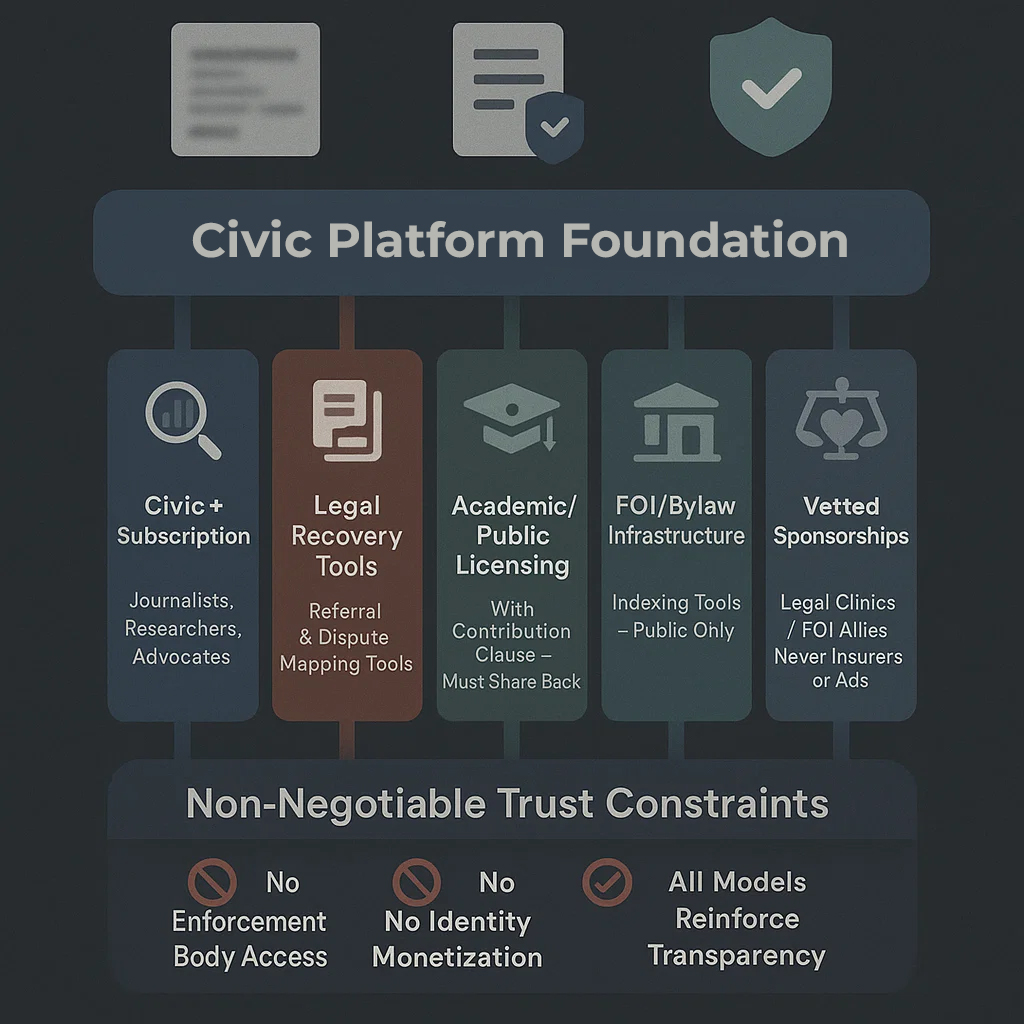

THIS STARTED WITH A TICKET AND A WALL
The System Was Built Because the Answers Weren’t
The platform began when its founder tried to get clarity on a single ticket and hit silence at every turn. No audit trail. No clear violation logic. No way to verify, dispute, or understand who issued what and why.
There was no system. Just power obscured by bureaucracy and protected by design.
So it was built from scratch: no team, no funding, just a commitment to map what enforcement looks like from the outside in.
- The first prototype was manual, but proved the need
- The logic came from lived experience, not abstraction
- The roadmap came from real world constraints, not pitch slides
This platform wasn’t imagined in a strategy session. It was built in frustration and rebuilt to make enforcement visible, structured, and accountable to the public it affects.
“This isn’t just tech. It’s a protest disguised as a product.”
THIS ISN’T A VISION. IT’S A DEPLOYMENT.
Milestone 1 Brings the Platform to Life AND Sets the Standard
Milestone 1 isn’t a demo or a trial. It’s a live deployment in three cities, chosen for contrast, scale, and origin. Sudbury. Toronto. New York City.
Every verified ticket becomes a civic record. Every contributor is protected. Every insight is public, not locked behind paywalls or platforms.
This raise doesn’t fund brand marketing or user acquisition. It powers the launch of public interest infrastructure, with contributor safeguards and auditability built in.
Aligned backers make this possible. Not for equity control. Not for data leverage. But to build the civic layer of enforcement accountability, the one governments never had a reason to create.
This is structure ready to stand up. And it’s ready to do it now.

